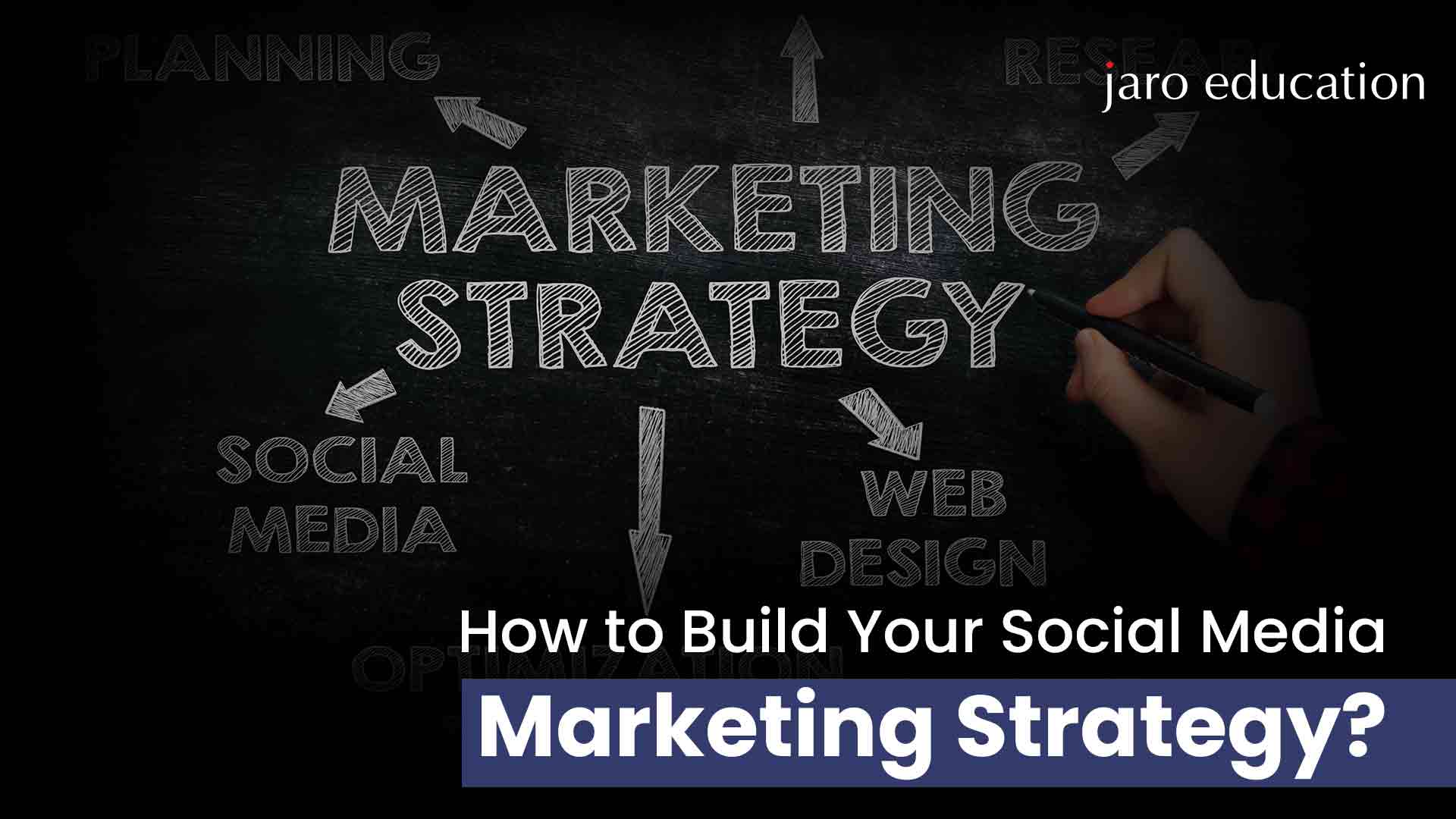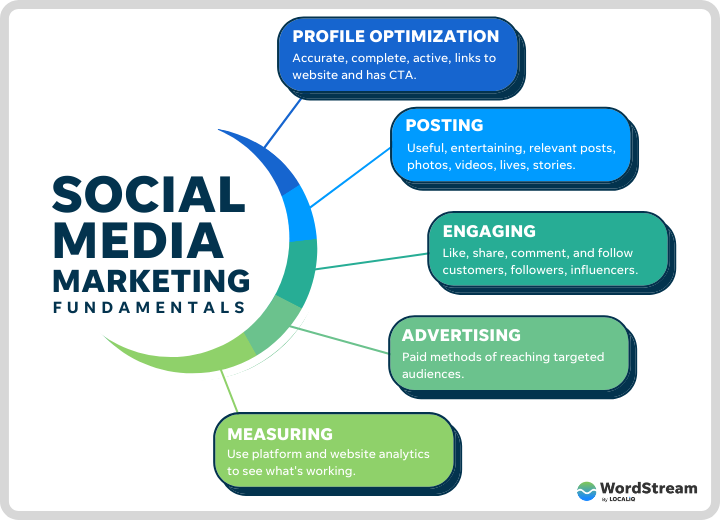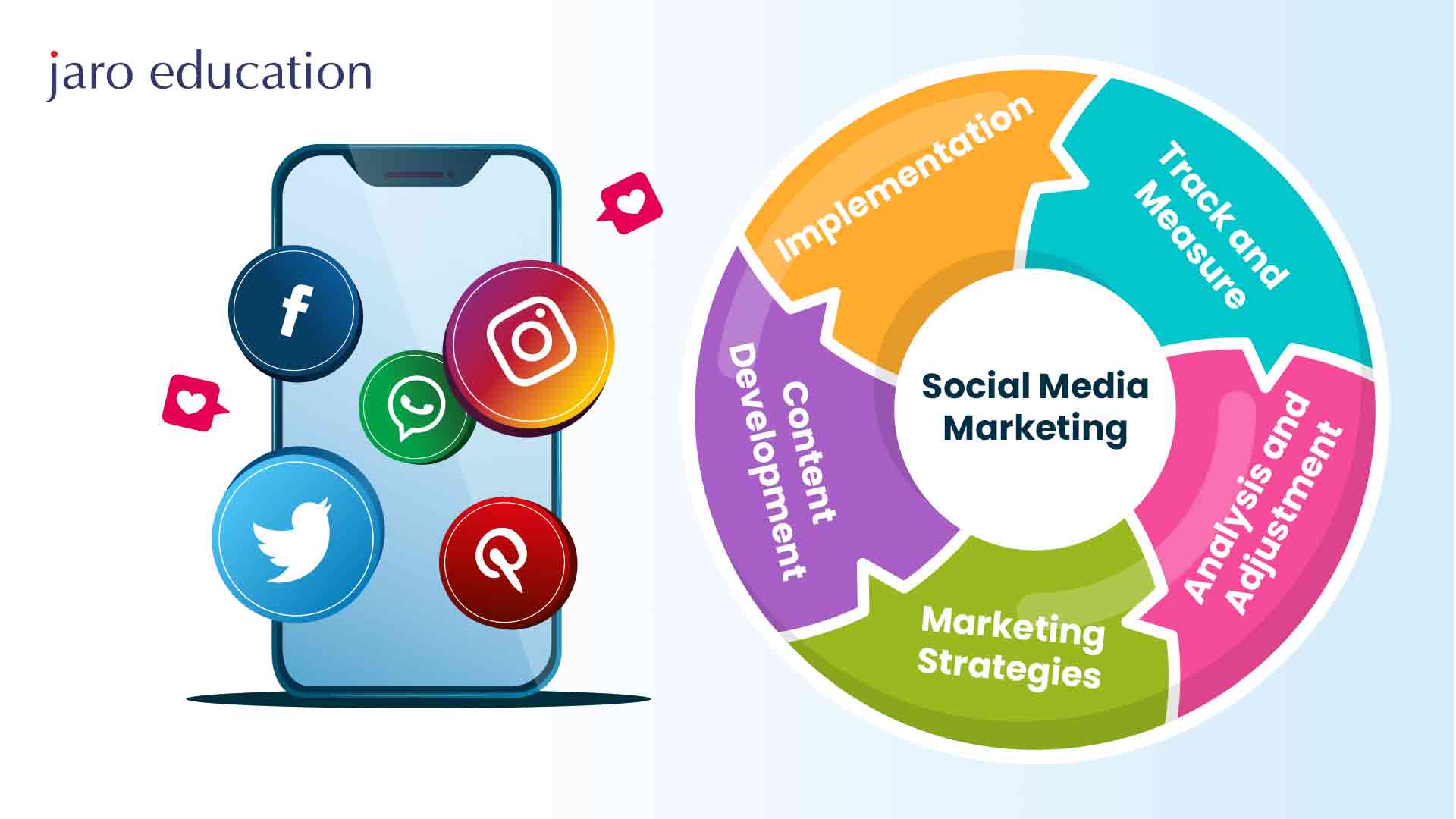How to Build Your Social Media Marketing Strategy?
Table of Contents

- jaro education
- 17, May 2024
- 10:40 am
Starting out in social media marketing can be like entering a confusing maze. Even experienced marketers can feel lost amidst the multitude of channels, tools, and features available. For newcomers to brand building or online presence, this landscape can seem daunting. But amidst the chaos, there’s one key to success: a well-thought-out social media marketing strategy.
Approximately 56.1% of internet users buy a product online at least once every week. It shows how much loss your business can have on social media without a plan. Without clear goals, target audiences, or content strategy, efforts are directionless. Understanding these basics is crucial for seeing real results from social media marketing.
In simple terms, random content leads to random outcomes. Whether you’re aiming to boost brand awareness or improve your marketing skills, a solid social media strategy is essential. Here in this article, you will learn how to build a social media strategy from scratch and make your social media campaign a big success.
What is Social Media Marketing and Why is It Important?
Social media marketing involves leveraging social media platforms such as Instagram, X (formerly known as Twitter), and Facebook to promote your brand and market your product or service.
For instance, if your company launches a new product and you intend to advertise the launch on social media, that falls under social media marketing. Similarly, engaging with your audience through comments and creating compelling content that reflects your brand’s values and narrative also falls within the realm of social media marketing.
Executing effective social media marketing necessitates proficiency in social media management techniques and tools. Just as you meticulously plan other components of your marketing strategy, devising a plan for your social media marketing efforts is crucial.

*wordstream
Here are some benefits of social media marketing:
- Improve Your Brand Identity: SMM can humanize your company, build trust, loyalty, authority, and recognition. By showcasing the people behind your brand and real users of your product, you enhance brand credibility and authenticity. Aligning your brand with values and actions that support activism and philanthropy can also greatly benefit your reputation.
- Engage the Audience: Unlike traditional media, social media allows direct interaction between customers and businesses. You can respond to posts, share user-generated content, and follow up with dissatisfied customers. Gathering customer perspectives on your products and services is easier than ever.
- Promote Customer Service: Social media platforms provide a channel for addressing customer inquiries, complaints, and feedback promptly. Timely responses can enhance customer satisfaction and loyalty.
- Impact Sales and Conversion Rates: By strategically promoting products and services, you can drive sales and improve conversion rates. Social media platforms allow you to showcase offerings, run targeted ad campaigns, and encourage purchases.
- Become a Thought Leader: Regularly sharing valuable content positions your brand as an industry expert. Thought leadership builds trust and attracts an engaged audience.
- Study the Competition: Social media enables you to monitor competitors, analyze their strategies, and learn from their successes and failures. This competitive intelligence informs your own marketing decisions.
- Improve SERP Presence: Active social media profiles contribute to search engine visibility. Consistent posting and engagement can positively impact your search engine rankings.
If you’re aiming to master social media marketing strategy, there’s no better teacher than an expert in the field. For those eyeing a career in social media and growth marketing, consider delving into the Post Graduate Certificate in Digital Marketing and Growth – IIM Visakhapatnam. This course presents a valuable chance for professionals to sharpen their skills in digital marketing and growth hacking. Covering essential areas like performance marketing, growth strategies, and tactics such as SEO, PPC advertising, content marketing, and social media marketing, it provides a comprehensive foundation for success in the digital world.
Step-by-Step Strategy for Social Media
Identify Your Target Audience
If you haven’t yet identified and documented your buyer personas, begin by outlining the key demographics of the audience you aim to target, including factors like age, gender, occupation, income, hobbies, and interests.
To effectively reach your audience with marketing that resonates rather than annoys, it’s crucial to understand their preferences and motivations. Consider why social media users engage with these platforms. Are they seeking to learn, discover, shop, or simply have fun?
In a recent survey on consumer trends, HubSpot polled over 500 general consumers about their primary reasons for using social media. Results showed that 65% use it for socializing with friends, 53% for entertainment, and 50% for learning. Additionally, 28% reported using social media specifically to discover new products or brands.
The survey also highlighted that 41% of consumers prefer researching and learning about brands and products through social media channels, indicating a growing trend from previous surveys.

While preferences vary across generations, with GenZ and Millennials showing a higher inclination for brand research on social media, it’s essential to tailor your strategy to your target audience’s behaviors and preferences.
Understanding your ideal consumer’s challenges and daily problem-solving activities is key. Focus on identifying no more than four primary buyer personas to streamline your marketing efforts without getting bogged down by exceptions or outliers.
Once you start creating content for your audience, prioritize engagement at every touchpoint. Address audience questions and comments promptly to foster a sense of community, as active engagement can significantly impact conversions and purchases.
Building a sense of community is crucial on social media platforms, as evidenced by the fact that more than 1 in 5 social media users have joined or participated in an online community within the past year.
Perform Competitive Analysis
Chances are high that your competitors are actively utilizing social media platforms, providing an opportunity for you to gain insights from their strategies. Conducting a competitive analysis enables you to identify your competitors and evaluate their strengths and weaknesses in social media marketing. This analysis helps you understand industry standards, allowing you to establish your own social media objectives effectively.
Moreover, it aids in identifying potential opportunities and weaknesses that can be documented in your social media strategy document.
You can track crucial information about your competitors in your social media strategy document. For instance, if one of your competitors is excelling on Facebook but neglecting platforms like Twitter or Instagram, you may consider focusing your efforts on platforms where your target audience is not receiving adequate attention, rather than competing directly with a dominant competitor.
Have a Social Media Audit
If you are currently active on social media platforms, it’s essential to evaluate your progress. Reflect on the following inquiries:
- What strategies are effective, and which ones are not yielding the desired results?
- Who is actively engaging with your content or profile?
- What partnerships have been the most beneficial for your brand?
- Which social media platforms does your target demographic primarily utilize?
- How does your social media presence compare to that of your competitors?
Once you have gathered this data, you can start brainstorming ways to enhance your social media strategies.
Conducting an audit will provide you with a clear understanding of the purpose behind each of your social media accounts. If the purpose of a particular account seems ambiguous, consider whether it is worth maintaining.
To aid in your decision-making process, ask yourself the following:
- Is my target audience present on this platform?
- If yes, how do they interact with content on this platform?
- Can this account contribute to achieving my business objectives?
Asking these critical questions will help you maintain a focused and effective social media strategy.
Create a Content Calendar
Your social media content calendar plays a key role in scheduling when and how you share content to achieve maximum impact. It’s essential to allocate time for engaging with your audience while also leaving room for spontaneous interactions.
Here are some steps to creating effective content calendar:
Establish a Posting Schedule:
Develop a social media content calendar that outlines the dates and times for publishing different types of content across various platforms. This calendar is where you plan all your social media activities, including image posts, sharing links, reposting user-generated content, publishing blog posts, and uploading videos. It includes both regular postings and content tailored for specific social media campaigns. Here is image will help to find the best time to post on social media.

Define the Content Mix:
Ensure that your content strategy and calendar align with the mission statement for each social media profile. This alignment ensures that every post contributes to supporting your business objectives.
You should consider the following approach:
- Allocate 50% of your content to drive traffic back to your website.
- Dedicate 25% of your content to curated materials from reputable sources.
- Designate 20% of your content to support lead-generation objectives such as newsletter sign-ups and ebook downloads.
- Devote 5% of your content to showcasing your company culture.
By incorporating these diverse post types into your content calendar, you can ensure a balanced mix that caters to various audience interests.
If you’re starting anew and uncertain about the types of content to share, consider applying the 80-20 rule:
- 80% of your posts should aim to inform, educate, or entertain your audience.
- Reserve 20% of your content for direct brand promotion.
Strike the Right Balance in Posting Frequency:
When starting a social media marketing strategy, finding the optimal posting frequency for each platform can be challenging. Posting excessively may irritate your audience, while posting too infrequently may suggest a lack of engagement. Strive to strike a balance that keeps your audience engaged without overwhelming them.
Here are some best practices for how often to post on different social media platforms:
- Instagram (Feed): Aim for 3-7 posts per week.
- TikTok: Post 3-5 times every week.
- Facebook: Share content 1-2 times per day.
- Twitter: Tweet anywhere from 1-5 times daily.
- LinkedIn: Post on LinkedIn 1-5 times daily.
Create an Engaging Content
Content is the king. The success of your social media marketing strategy heavily relies on the quality and relevance of your content. By now, you likely have a clear understanding of what type of content to create based on your objectives, target audience, and brand identity. You may also have a good grasp of which social media platforms to prioritize.
Developing a content strategy may seem daunting initially, but it essentially boils down to aligning with your goals. For example:
- Are you aiming to educate your audience in the B2B sector? Focus on publishing blogs, news updates, and thought-provoking opinions relevant to your industry.
- If your goal is to promote e-commerce products, showcase action-oriented images of your products and user-generated content displaying your merchandise in use.
- For those prioritizing customer service, sharing tips, acknowledging customers, and providing regular company updates are essential.
Here are key considerations to remember as you shape your content approach:
- Establishing a Unique Brand Voice: Standing out on social media often involves defining a distinctive brand voice. You’ve likely encountered posts from certain brands that are instantly recognizable due to their tone and style.
- Consistent Content Formats: Many successful brands consistently use specific content formats, from engaging graphics to attention-grabbing Reels. This consistency helps in establishing a cohesive content strategy.
- Personalized and Relatable Content: Incorporating personal and relatable content should be a cornerstone of your social media strategy. Showcasing the human side of your brand can resonate well with your audience, as authenticity is highly valued by consumers.
- Leveraging the Creator Economy: Consider tapping into the creator economy if you haven’t already. Research indicates that collaborating with content creators and influencers can significantly impact brand recall and purchase decisions. Effective social partnerships can drive website traffic, create compelling content, and influence consumer behavior positively
Maintain Your Social Media Presence
Creating and maintaining a strong social media presence requires staying current and responsive, especially in today’s fast-paced marketing landscape. Timeliness is key, demanding not just consistent content creation but also constant engagement with your audience. However, expecting customers to operate solely on your schedule isn’t realistic, particularly for smaller teams or those with limited resources.
To optimize your social media efforts and make the most of your time, consider the following strategies:
- Develop a content calendar: Utilize a content calendar to plan and organize your posts in advance. This approach saves time and prevents overusing the same content.
- Post during peak engagement times: Identify the best times to post based on your audience’s activity. Use tools and analytics to automate posting during these optimal periods, ensuring maximum reach and interaction. However, it’s crucial to have team members available to engage with users after posting, and addressing questions or feedback promptly. The image below will help you to decide which is the best time to post on social media.
- Utilize AI and automation: Leverage artificial intelligence and automation tools such as chatbots or automated replies to handle customer inquiries and interactions efficiently, especially when your team is offline. This allows for quicker responses and enhances overall customer satisfaction.
Keep Monitor Your Social Media Effort
At this point, you should have gained a comprehensive understanding of your social media strategy. Nonetheless, it is crucial to continually refine your approach throughout the year.
Failing to regularly evaluate your efforts means you won’t have a clear comparison of one campaign’s performance against another. Taking a broad view of your social media activities helps provide perspective. This involves analyzing your most successful content and making adjustments when your content’s performance starts to decline.
It’s evident that much of social media success relies on trial and error. Monitoring your campaign metrics in real time enables you to make minor adjustments to your social media marketing strategy rather than undertaking extensive, time-consuming changes.
Effective social media marketing begins with a conscientious approach to data. You can react swiftly in the short term to optimize your ongoing campaigns and then use these insights proactively to shape your future strategy adjustments.
Final Thoughts
These strategies we’ve discussed are sure to boost your returns in today’s fast-paced social media world. But remember, the internet keeps changing. New tools, websites, and trends pop up all the time. To stay successful, you’ve got to be ready to adapt. Keep learning and adjusting your approach. That way, your social media marketing will keep working well even as things evolve.
Your strategy isn’t something you finish and forget about. It’s always a work in progress. So, make it a habit to check in on your plan every few months. See what’s working and what needs tweaking. With this mindset, you’ll keep growing and improving your social media presence.










1 thought on “How to Build Your Social Media Marketing Strategy?”
Building a strong social media strategy starts with understanding your audience. Know who you’re talking to, choose the right platforms, create engaging content, and track what works. Consistency is key! Remember, it’s a marathon, not a sprint. For more valuable resources and services similar to our discussion, explore https://bawejamedia.com/